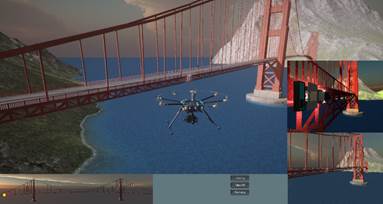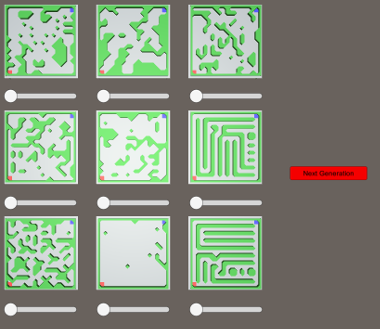
We use an iterative software engineering process to investigate and build a series of Simulation Training And Control System (STACS) prototypes within the Unity3d game engine. STACS will be used for both operator training (in simulation) and operator control of robot team including multiple drones and climbing robots in the real world during an inspection.
The image shows a screenshot from an early STACS prototype.
The objectives of this project are to investigate and build a Simulation Training And Control System for Bridge Inspection within a 3D simulation game-like environment in order to...
(1) Investigate and optimize the design of user interaction and user interfaces within a full 3D game-like environment for training and control.
(2) Investigate and optimize the tradeoff between manual and autonomous control of multi-robot teams for bridge inspection. Then, using the results of our investigations, design and develop a realistic simulation training environment.
(3) Train bridge inspectors in the use of the proposed multi-robot system.
(4) Provide human operators complete situational awareness as well as operational control during an ongoing inspection.
We attack the problem of evolving high performance micro behaviors in 3D RTS-game-like simulations with Meta-Search approach. We compare the evolved micro performance of our entities with different physics models of motion on the same scenarios against identical opponent units in a 3D RTS simulation. The genetic algorithm approach works to reliably evolve high quality 3D micro behaviors for entities independent of the physics model used.
Can we effectively use ITS to perform knowledge tracing in order to accurately estimate the student’s level of knowledge? Intelligent Tutoring system is a promising approach which is recognized as an effective way for learning. RoR-ITS, an interactive training system is proposed, which is aimed at teaching midshipmen about different ship types, target angle, identifying ship activities by looking at ship navigation lights during night.
These projects are developed using c# and Unity. These projects provide a new game UI for K-16 and lay audiences to learn the science behind Nevada climate change. This helps them to understand the complex scientific concepts in an immersive, more competitive and more interactive way.
In this project we developed an interface in which UAV agents such as drones are used for collecting information from disaster affected areas. Further, with the obtained data, commanders can take prompt actions for rescuing victims. Drones can aid in the search to locate victims, thereby decreasing the risk to emergency personnel.

In this project we use neuroevolution of augmenting topologies(NEAT) to evolve control tactics for groups of units in real-time strategy games. The evolved network controls the movement and attack commands for a group of ranged units skirmishing with a group of melee units. NEAT evolved neural networks that lead to kiting behavior for the ranged units which is a common tactic used by professional players in ranged versus melee skirmishes in popular RTS games like Starcraft. The evolved neural networks also generalized well to other starting positions and numbers of units. For further details, https://www.cse.unr.edu/~aavaas
Real time strategy (RTS) games provide a great challenge to the computational intelligence and artificial intelligence community. Knowing your opponent's strategy is a crucial aspect of RTS games. This helps player decide what type of units need to be built or how to control different groups of units. We use Co-Evolution based evolutionary approach, where each player evolves against each other's different strategies. We focus on micro-management and use influence map, potential fields to select a target and control unit movements towards the target location during skirmishes in Star Craft 2; a popular RTS game. For further details, https://www.cse.unr.edu/~rahuld/
We investigate an evolutionary multi-objective approach to good micro for real-time strategy games. Good micro helps a player win skirmishes and is one of the keys to developing better real-time strategy game play. This project uses evolutionary multi-objective optimization to generate micro for one group composed from both ranged and melee units versus another group of ranged and melee units. Our micro behavior representation uses influence maps to represent enemy spatial information and potential fields generated from distance, health, and weapons cool down to guide unit movement. For further details, https://www.cse.unr.edu/~rahuld/
In this project, we investigate competitive co-evolution of unit micromanagement in real-time strategy games. We remove the need for a good opponent to evolve against by using competitive co-evolution to evolve high-quality micro for both sides from scratch. We first co-evolve micro to control the movement and attack commands for a group of Vultures (StarcCaft ranged units) versus a group of Zealots (StarcCaft melee units). We then move to co-evolve micro for a group of Vultures and Zealots versus a group of Vultures and Zealots. The co-evolved Vultures can do kiting against Zealots while co-evolved Zealots can circle and corner the Vultures. For further details, https://www.cse.unr.edu/~navin